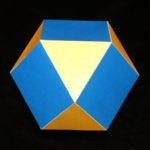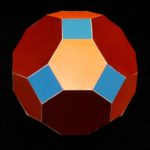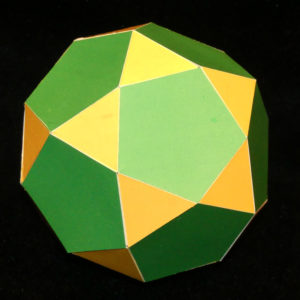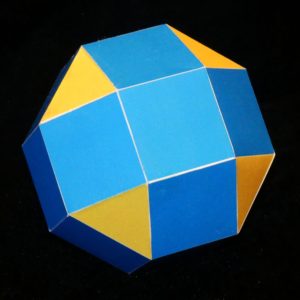We started with the 5 Regular (Platonic) Solids by taking just one flat polygon as the basis for each one. Varying that rule by allowing more than one type of polygon leads to the Semi-Regular or Archimedean Polyhedra. (The Greek mathematician Archimedes wrote a book about them sometime around the year 280BC, though sadly his book got lost somewhere between then and now.)
The first five of these new solids look as if we’ve cut the corners off the existing Platonic solids – so we use the term Truncated. But the faces themselves are all still regular polygons – hexagons, octagons etc – and the combination of them round each vertex is consistent (triangle-hexagon-hexagon etc)
If you imagine making these truncations by cutting thin slices off potato shapes, you might well find you’d taken too much off. (Try it next time you’re peeling a potato…) The Cube and Octahedron, and the Dodecahedron and Icosahedron, have a couple of neat relationships here: it turns out that if you cut too much off the corners of any one of them it starts to look like its partner. Get things just right in the middle and you end up with two lovely half-way shapes, named so as to highlight the connections:
We now have seven shapes derived by chopping the corners off the Platonic solids, so it’s tempting to think we could try chopping the corners off some of these Archimedeans too and discover some new ones. That doesn’t quite do the trick, though: instead of getting square corners we get rectangles. And since rectangles aren’t ‘regular’ they’re not allowed, though these shapes do have a certain charm of their own.
The Cuboctahedron and the Icosidodecahedron, though, have so much ‘good’ geometry around them that we can make things work if we also pull the existing faces apart a little to square everything up. To reflect this contortion we use the word Rhombic, which in this context means ‘we’ve stretched those rectangles a bit to make them squares’. And because we’ve chopped the corners off, triangles also become hexagons, squares become octagons, and pentagons become decagons. (This is the first time we’ve encountered octagons and decagons, but there’s no reason why we shouldn’t get used to them.)
Curiously we can now collapse the more complex polygons down again: think of this as letting those squares expand a bit to soak up some of those extra edges. We still call these Rhombic, but the words Large and Small help us distinguish where we’ve got to.
Stand back from these for a moment and you can see we’ve still got the basic forms of the cuboctahedron and icosidodecahedron: all we’ve done is pull them apart and rough them up a bit. There’s one more contortion that we can do, which involves inserting not squares but pairs of triangles in parallelogram formation. Making things fit together requires a bit of twisting, which distorts their perfect symmetry – but they’re still valid according to our definition of Archimedean, or semi-regular, polyhedra as having exactly the same configuration round each vertex. To reflect their twisted nature we introduce the word Snub:
This accounts for all 13 Archimedean solids – and by a similar argument to the Platonics, there can’t be any more because we’ve tried every possible combinations of polygons around the vertices. They make a beautiful collection, yet they really come from just two underlying structures – Cuboctahedral and Icosidodecahedral – with the Truncated Tetrahedron as an extra little baby one. If you can hold these two structures in your head, all the rest is just details!
The next step is to go non-convex and discover The 4 Star (Kepler-Poinsot) Polyhedra.

























